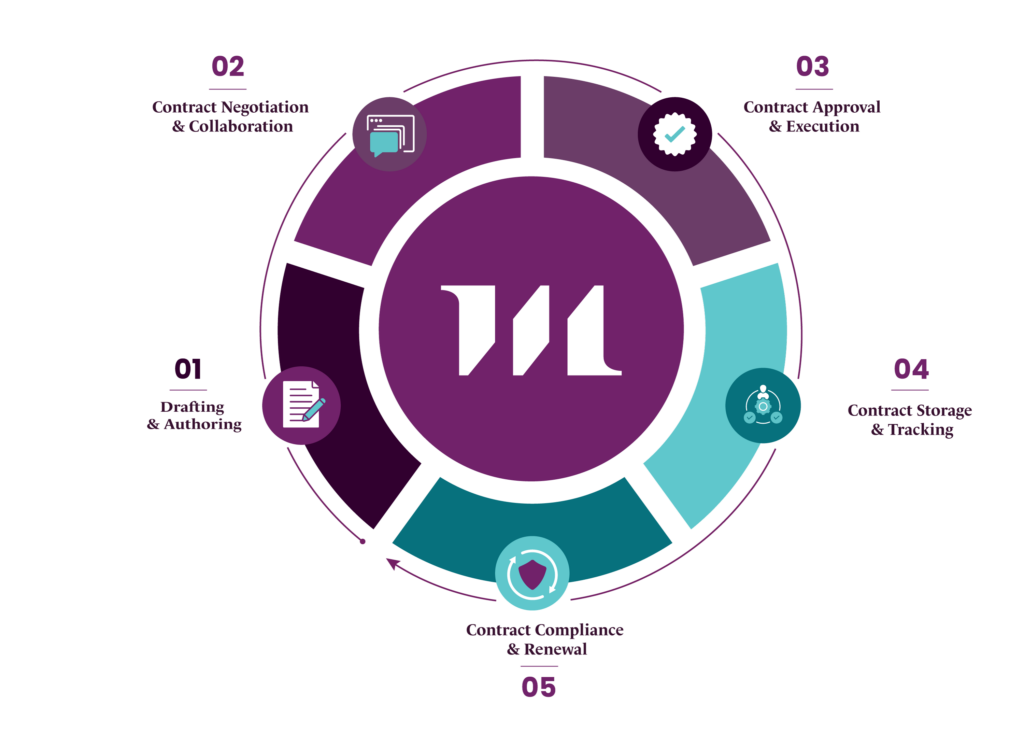Contract Lifecycle Management – The Ultimate Guide to CLM
Contract lifecycle management is as old as contracts themselves, but for a long time it was all about memorized numbers, data entered manually into spreadsheets, and risks from human error.
Modern CLM solutions, which now include artificial intelligence, offer a variety of benefits for different departments in organizations to reduce risk, increase efficiency, and easily manage up to tens of thousands of contracts simultaneously.
In this article, we take a look at modern CLM systems and how they can help your business grow and operate with confidence.
What is Contract Lifecycle Management?
Contract lifecycle management (CLM) is a comprehensive approach to managing contracts throughout their entire lifecycle, from creation to renewal or termination. It encompasses the processes, tools, and best practices used to streamline and optimize the contract management lifecycle.
At its core, CLM involves the systematic handling of all contract-related activities, including drafting, negotiating, approving, executing, tracking, and analyzing contracts. It ensures that contracts smoothly transition through each stage of the contract management lifecycle, reducing bottlenecks, minimizing risks, and improving overall efficiency.
The contract lifecycle management process covers the end-to-end journey of a contract, from the initial request or need for an agreement to its eventual expiration or renewal. This lifecycle typically includes stages such as contract authoring, collaboration and negotiation, approval workflows, execution and signatures, storage and tracking, compliance monitoring, and renewal or termination procedures.
By adopting a structured CLM approach, organizations can gain better control over their contracts, ensure compliance with legal and regulatory requirements, and maximize the value derived from their contractual relationships. Effective contract lifecycle management enhances visibility, reduces manual effort, and enables organizations to make data-driven decisions regarding their contractual obligations and opportunities.
The Stages of the Contract Management Lifecycle
A contract management lifecycle consists of several key phases that span the entire journey of a contract, from its initial conception to its eventual expiration or renewal. Understanding these stages is critical for companies to effectively manage their contractual agreements and optimize their contract processes.

Stage 1 – Contract Drafting and Authoring
This stage involves the creation of a new contract or the modification of an existing agreement. It typically begins with gathering requirements, selecting the appropriate contract template, and drafting the initial version of the contract. This process often involves collaboration between legal teams, subject matter experts, and relevant stakeholders to ensure the contract accurately captures the intended terms and conditions.
Stage 2 – Contract Negotiation and Collaboration
Once the initial draft is prepared, the contract enters the negotiation phase. This stage involves collaboration and negotiation between the contracting parties to refine the terms and conditions of the agreement. During this phase, parties exchange comments, propose revisions, and engage in back-and-forth discussions until a mutually acceptable version is achieved.
Stage 3 – Contract Approval and Execution
After the negotiation phase, the contract must undergo a formal approval process. This typically involves review and sign-off from various stakeholders, such as legal teams, procurement departments, and executive leadership. Once approved, the contract is executed, often through electronic signatures or traditional wet-ink signatures, making it legally binding.
Stage 4 – Contract Storage and Tracking
Once executed, the contract enters the storage and tracking phase. This stage involves securely storing the contract in a centralized repository and establishing mechanisms for tracking key dates, milestones, and obligations. Proper contract storage and tracking ensure easy access to contract information and enable effective monitoring of contractual commitments.
Stage 5 – Contract Compliance and Renewal
Throughout a contract lifecycle, organizations must monitor compliance with the agreed-upon terms and conditions. This includes tracking performance metrics, managing deliverables, and ensuring adherence to legal and regulatory requirements. As the contract nears its expiration date, organizations must decide whether to renew, renegotiate, or terminate the agreement, initiating a new cycle in the contract management lifecycle.
Why is Contract Lifecycle Management Important?
Effective contract lifecycle management is crucial for organizations and delivers numerous benefits that can significantly impact overall operations, compliance, and profitability. By implementing a robust contract lifecycle management tool, businesses can unlock several key advantages:
Increased Efficiency and Productivity
Manual contract management processes are often time-consuming, error-prone, and inefficient. Enterprise contract lifecycle management solutions automate many of these tasks, streamlining workflows and reducing the administrative burden on employees. This increased efficiency translates into higher productivity, allowing teams to focus on more strategic and value-adding activities.
Improved Compliance and Risk Mitigation
Contracts are legally binding documents, and failure to adhere to their terms and conditions can expose organizations to significant risks and penalties. Effective contract lifecycle management tools help organizations maintain compliance by tracking obligations, deadlines, and key clauses. Additionally, these solutions provide visibility into contract performance, enabling proactive risk identification and mitigation.
Better Visibility and Control over Contracts
Organizations often struggle with managing a large volume of contracts scattered across different locations and systems. Contract lifecycle management solutions provide a centralized repository for all contracts, enabling easy access, search, and retrieval. This improved visibility and control over contracts empower organizations to make informed decisions and capitalize on opportunities.
Cost Savings and Revenue Optimization
Reducing manual efforts, and ensuring compliance, contract lifecycle management solutions can deliver significant cost savings for organizations. Additionally, these solutions can help identify revenue leakages, optimize pricing strategies, and unlock new revenue streams by providing insights into contract performance and potential opportunities.
In addition, enterprise contract lifecycle management plays a critical role in facilitating collaboration between the various stakeholders involved in the contract management process, including legal, procurement, sales, and finance teams.
Benefits for Specific Teams
Contract lifecycle management solutions bring substantial benefits to different teams within an organization. They simplify complex processes, improve collaboration, and help everyone make smarter decisions.
Legal Teams
Contract lifecycle management software for legal departments is invaluable. These solutions help legal teams efficiently manage and review a wide range of contracts, such as non-disclosure agreements (NDAs), employment contracts, and vendor agreements.
CLM tools provide centralized document storage, version control, and collaboration features, ensuring that legal teams have access to the most up-to-date contract information. Additionally, CLM software can automate routine tasks, such as clause library management and contract template creation, allowing legal professionals to focus on more complex legal matters.
CLM solutions offer robust risk management capabilities, enabling legal teams to identify potential risks and compliance issues within contracts proactively. Automated risk assessments and intelligent clause analysis help mitigate legal liabilities and ensure regulatory compliance.
CLM software also provides valuable analytics and reporting features, offering insights into contract performance, obligations, and key metrics. These analytics empower legal teams to make data-driven decisions and optimize their contract management processes.
Furthermore, scalability is a crucial benefit of CLM solutions for legal departments. As an organization grows, the volume of contracts and legal agreements increases. CLM software can seamlessly scale to handle increasing contract volumes, ensuring that legal teams can manage their workload effectively without compromising efficiency or accuracy.
Sales Teams
Sales teams often deal with a high volume of sales contracts, proposals, and agreements. Contract lifecycle management systems can significantly improve the sales cycle by automating the creation, negotiation, and execution of these documents.
Pre-approved clauses and templates created by the legal team ensure consistency and reduce the risk of non-compliance. This balance enables sales teams to close deals faster without compromising on legal standards. Automated approval workflows and real-time collaboration capabilities further improve the efficiency and accuracy of contract management, ensuring sales and legal teams work together seamlessly.
This refreshed process reduces delays, improves the customer experience, and ultimately contributes to faster revenue realization.
Procurement Teams
Procurement teams are responsible for managing a wide range of contracts, including vendor agreements, purchase orders, and statements of work (SOWs). CLM solutions provide procurement professionals with a centralized platform for contract authoring, negotiation, and tracking. By integrating with existing procurement systems, CLM tools can automate the creation of purchase orders and streamline the approval process.
Additionally, CLM software can assist in monitoring contract performance, identifying potential cost savings, and ensuring compliance with established procurement policies and regulations. These solutions also facilitate effective supplier relationship management by providing a comprehensive view of vendor contracts, performance metrics, and communication histories. This transparency enhances collaboration and strengthens relationships with key suppliers.
CLM solutions also play a critical role in mitigating risk for procurement teams. By analyzing contract clauses and terms, these tools can identify potential risks related to pricing, delivery, or compliance. By proactively identifying risks, procurement teams can take preventative action and mitigate potential issues before they escalate.
Cost control is another key benefit of CLM software for procurement teams. These solutions help optimize pricing strategies, monitor spend against contracted rates, and track cost-related commitments.
Finance and Operations Teams
For finance and operations teams, contract lifecycle management offers valuable insights and control over contractual obligations and financial commitments. CLM solutions can integrate with financial systems, enabling finance teams to accurately forecast revenue and expenses based on contractual terms.
These tools can provide visibility into upcoming contract renewals, auto-renewals, and termination clauses, allowing finance teams to proactively manage budgets and cash flow. Operations teams can also benefit from CLM solutions by monitoring service-level agreements (SLAs) and ensuring adherence to contractual performance metrics.
CLM systems also support scalability, enabling finance and operations teams to manage growing contract volumes without compromising accuracy or efficiency. Integration capabilities with other enterprise systems ensure seamless workflows and data consistency across the organization.
What is Contract Lifecycle Management Software and What are the Benefits?
Modern contract lifecycle management software solutions are designed to offer a comprehensive suite of features that cater to the diverse needs of organizations across various industries. To effectively manage contracts from start to finish, these solutions should encompass the following essential features:
- Contract Authoring and Template Management: A robust CLM system should provide a user-friendly interface for contract creation and template management. This allows users to generate new contracts using pre-approved templates or create custom templates tailored to specific requirements. Additionally, it should enable version control, clause libraries, and the ability to incorporate dynamic data fields for efficient contract authoring.
- Collaboration and Negotiation Tools: Effective contract management often involves collaboration among multiple stakeholders, both internally and externally. CLM software should facilitate this process by offering collaboration tools such as real-time co-authoring, commenting, and redlining capabilities. These features enable seamless negotiation, ensuring that all parties can contribute to the contract’s development and track changes throughout the lifecycle.
- Electronic Signatures and Approvals: CLM solutions should integrate secure electronic signature capabilities, enabling parties to sign contracts remotely and efficiently. Additionally, they should offer configurable approval workflows, allowing organizations to define and enforce specific approval processes based on their internal policies and requirements.
- Centralized Contract Repository: A key component of CLM software is a secure and centralized repository for storing and organizing all contracts and related documents. This feature should provide advanced search and filtering capabilities, enabling users to quickly locate and retrieve relevant contracts based on various criteria, such as contract type, parties involved, or expiration dates.
- Contract Analytics and Reporting: CLM solutions should offer robust analytics and reporting functionalities, providing insights into contract performance, compliance, and risk factors. These capabilities should include customizable dashboards, automated alerts for key dates and milestones, and the ability to generate comprehensive reports on contract metrics, obligations, and financial implications.
- Integration with Other Business Systems: To optimize efficiency and minimize data silos, CLM software should seamlessly integrate with other critical business systems, such as customer relationship management (CRM), enterprise resource planning (ERP), and procurement platforms. This integration enables bi-directional data flow, ensuring that contract information is accessible and up-to-date across various departments and processes.
In addition to these core features, modern CLM software may also offer advanced capabilities such as artificial intelligence (AI), Generative AI, Natural Language Processing (NLP), and machine learning (ML) for intelligent contract review, risk assessment, and automated clause extraction. These cutting-edge technologies can further enhance the efficiency and accuracy of contract management processes.
By incorporating these essential features, contract lifecycle management software empowers organizations to streamline their contract processes, mitigate risks, and unlock valuable insights from their contractual agreements, ultimately driving better business outcomes and competitive advantage.
Artificial Intelligence in Contract Lifecycle Management
Artificial intelligence in contract lifecycle management is transforming how organizations handle contracts, bringing efficiency, accuracy, and insights to the entire process. AI enhances several key aspects of CLM, making it an invaluable tool for modern businesses.
AI-assisted Contract Drafting and Review
AI-assisted contract drafting and review significantly reduce the time and effort required to create and vet contracts. AI tools can generate initial drafts using pre-approved templates and standard clauses, ensuring consistency and compliance. These tools streamline the drafting process, allowing legal to quickly produce accurate and standardized documents.
More advanced AI tools offer automatic clause routing and assist with nuanced guardrails, automatically reviewing and evaluating conditions against a clause library or playbook. For example, if a counterparty modifies payment terms, the AI can detect this change and route the document to the finance team for review. This automated process ensures that specific departments are involved when their expertise is needed, improving overall efficiency and accuracy.
During the review process, AI algorithms identify discrepancies, suggest edits, and highlight potential risks. These capabilities allow legal teams to focus on more complex, strategic tasks, rather than getting bogged down in routine contract reviews. By leveraging AI, organizations can enhance the speed and quality of their contract management processes, ultimately reducing risks while improving compliance.
Intelligent Contract Analysis and Risk Assessment
Intelligent contract analysis and risk assessment are central to managing contractual obligations and mitigating risk. AI-powered tools analyze large amounts of contract data to identify patterns and flag high-risk clauses or provisions. This proactive approach helps companies avoid potential legal issues and ensure regulatory compliance, ultimately reducing liabilities. More advanced AI tools will assess clauses and visualize if language favors your company, counterparty, or if it represents a balanced position — understand, leverage, and guide your position in negotiations.
Automated Contract Tracking and Reminders
Automated contract tracking and reminders ensure that key dates and milestones are never missed. AI systems monitor contract timelines, send notifications for upcoming renewals, expirations, or obligations, and maintain an organized schedule. This reduces the risk of missed deadlines and allows for timely decision-making, keeping contract management on track and efficient.
Extract and track contract-related events and routes to a particular party, such as payment schedules, performance milestones, and compliance requirements. More advanced AI capabilities in CLM will allow you to track key provisions in your contract repository without any manual data entry or tagging. For example, if you need to find all the contracts with Termination for Convenience language and go to the point in the document right from a search window — no extensive “search queries” or complex reports are required.
Machine Learning for Contract Optimization
Machine learning for contract optimization involves continuously improving contract processes through data analysis. By learning from past contract performance, machine learning algorithms can suggest optimal terms, pricing strategies, and negotiation tactics. This data-driven approach helps organizations maximize the value of their contracts, enhancing both operational efficiency and profitability.
Artificial intelligence in contract lifecycle management is not just a technological advancement but a strategic asset that can lead to significant improvements in how organizations manage their contractual relationships.
Choosing the Right Contract Lifecycle Management Solution
Selecting the best contract lifecycle management software for your organization is crucial for maximizing efficiency and ensuring compliance. Here are key factors to consider.
Organization Size and Contract Volume
The size of your organization and the volume of contracts you manage are primary considerations. Larger organizations with high contract volumes need robust CLM solutions that can handle extensive data and complex workflows. Conversely, smaller organizations may benefit from more straightforward, cost-effective solutions that cater to their specific needs without unnecessary complexity.
Specific Industry Requirements and Compliance Needs
Industry-specific requirements and compliance needs are critical when choosing a CLM solution. Industries such as healthcare, finance, and government have stringent regulatory requirements. Ensure that the CLM software you select can support these compliance needs by offering features like automated compliance checks, audit trails, and secure storage of sensitive data.
Integration with Existing Business Systems
A CLM solution should integrate seamlessly with your existing business systems, such as customer relationship management (CRM), enterprise resource planning (ERP), and procurement platforms. This integration ensures a smooth flow of data across systems, reducing manual data entry and improving overall efficiency. Ensure that you are choosing a solution with no-code integrations for easy adoption and ongoing success.
Scalability and Customization Capabilities
Scalability and customization capabilities are essential for a CLM solution to grow with your organization. Choose software that can adapt to increasing contract volumes and evolving business needs. Customization options allow you to tailor the software to fit your specific workflows and processes, enhancing its effectiveness.
User-friendliness and Ease of Adoption
The user-friendliness and ease of adoption of a CLM solution are crucial for ensuring widespread acceptance and effective use within your organization. Look for software with an intuitive interface, comprehensive training resources, and strong customer support. A solution that is easy to implement and use will minimize disruption and accelerate the benefits of AI in contract lifecycle management.
By carefully evaluating these factors, you can select a CLM solution that aligns with your organizational needs and drives significant improvements in contract management efficiency and compliance.
Implementation Best Practices
Successfully implementing a CLM solution involves:
- Establishing Clear Objectives and Success Metrics: Define measurable goals such as reducing approval times and enhancing compliance.
- Involving Stakeholders from Various Teams: Engage legal, procurement, sales, and finance teams early for comprehensive input.
- Proper Data Migration and Integration: Ensure accurate data migration and seamless integration with existing systems like CRM and ERP.
- User Training and Change Management: Provide thorough training and support to encourage adoption.
- Continuous Monitoring and Optimization: Regularly review performance, gather user feedback, and make necessary adjustments, leveraging AI in contract lifecycle management for ongoing improvements.
Learn more about CLM implementation Dos and Don’ts in our dedicated guide.
Conclusion
Effective contract lifecycle management is crucial for your organization to reduce risks, ensure compliance, and maximize contract value. By adopting a modern, AI-powered CLM solution, you can enhance every stage of your contract management process. AI-driven tools can streamline drafting, analysis, tracking, and optimization, boosting efficiency and accuracy. Choosing the right solution and following best practices for implementation will empower your team to manage contracts more effectively and achieve better business outcomes.
Now is the time to explore your options and take proactive steps to revolutionize your contract management processes. Your organization’s success starts with smarter contract management.







